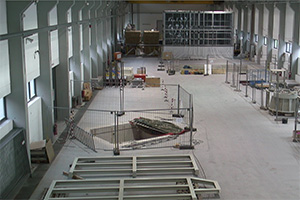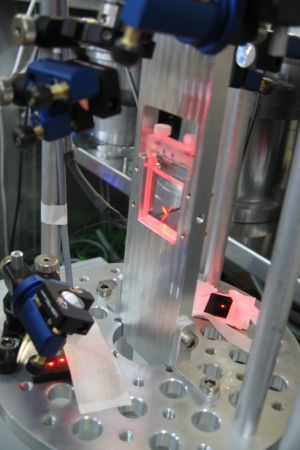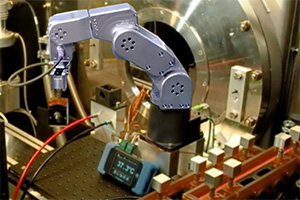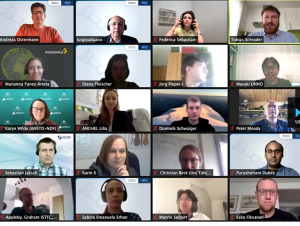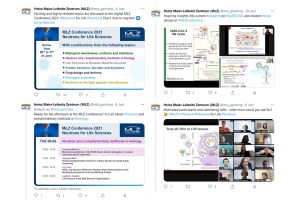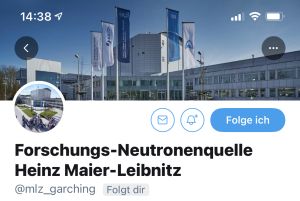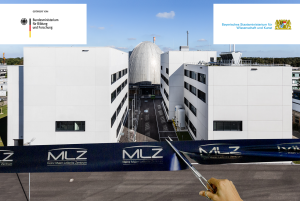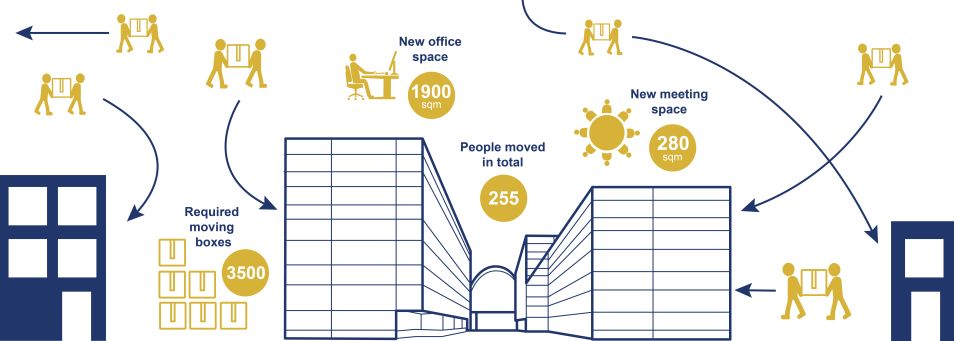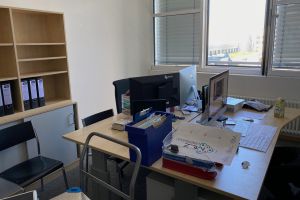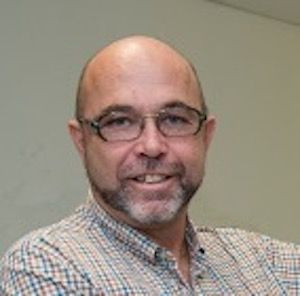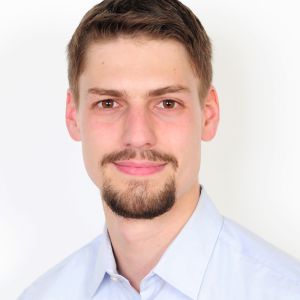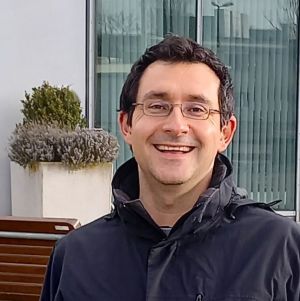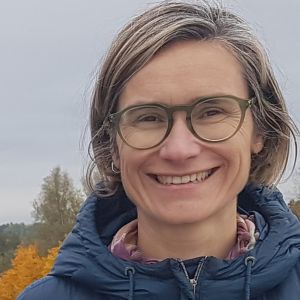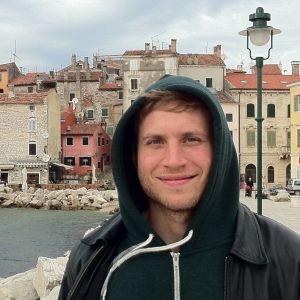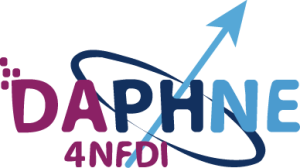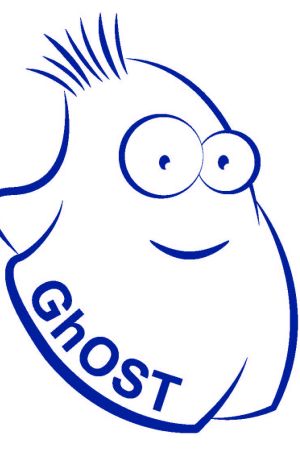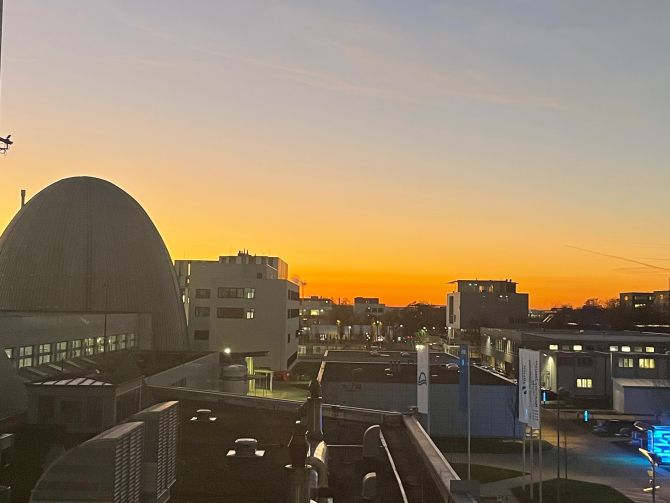MLZ is a cooperation between:
 > Technische Universität München
> Technische Universität München > Helmholtz-Zentrum Hereon
> Helmholtz-Zentrum Hereon
 > Forschungszentrum Jülich
> Forschungszentrum Jülich
MLZ is a member of:
 > LENS
> LENS > ERF-AISBL
> ERF-AISBL
MLZ on social media:

MLZ (eng)
Lichtenbergstr.1
85748 Garching
Newsletter I/2021
Jump directly to the chapters! (and don't forget to enlarge the pictures by clicking them!)
» Editorial» Instrumentation» on-line & on-site» People» UsersEditorial
Waiting not only for neutrons
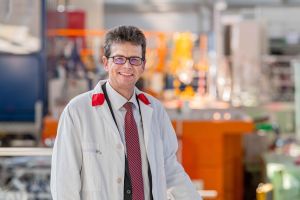
Editorial by Prof. Dr. Peter Müller-Buschbaum (Scientific Director FRM II/ Scientific Director MLZ) © A. Heddergott/ TUM
In the last two years, we were lacking a substantial number of operation days of our neutron source FRM II. Caused by legal issues on the transport of fuel elements from our supplier in France and the still ongoing Covid pandemic, we only could offer very limited access in the years 2019 and 2020. Especially the impact of the Covid pandemic and the related access restrictions pushed us to implement additional sophisticated online tools to enable remote access, in case users will not be able to come on-site to Garching. These online tools not only implement a remote control of the measurements in close collaboration with the local contact and the entire instrument team. It includes the full suite of software to evaluate the collected data and enables an optimised measurement strategy during the available beam time.
Being well prepared to restart our user programme in spring this year, however, we discovered technical problems with our cold source. These difficulties hit us unanticipated, as all cryogenic systems did not show any unusual behaviour and the operation of the cold source turned out to be very reliable over the last 15 years. All our effort is concentrated now to overcome this problem in order to restart our user operation in the second half of 2021. We will keep you informed as soon as we can decide on a restart and conditions for the user service in the upcoming months.
All our staff is very eager to get back our beloved neutrons, but in the same way, we are missing the pleasing collaboration with our users, performing fascinating experiments and fruitful collaborations. Hope to see you all back at the MLZ in the near future!
Instrumentation
» Let's do the time warp!» Lightsabers for the Phoenix
» Helping hands for the future
Let's do the time warp!
All staff members here at MLZ know the Neutron Guide Hall East very well – some of us are working above it like the User Office, others work inside and help to equip it with installations, media connections, measuring cabins, and now slowly with instrument parts. And those who are here for some years now, always remember the times when the hall was really empty…
Now you can see what they are talking about!
In 2012, we installed a camera inside the hall that takes a picture every 15 minutes. Apart from a short technical break, they summed up to more than 120,000 pictures until now! We picked the best ones and cut a short time lapse movie. Lean back and look how the hall became crowded over the years!
Lightsabers for the Phoenix
The neutron spin echo spectrometer J-NSE „PHOENIX“ explores slow motions on length scales of nanometers, such as thermally driven fluctuations of polymer chains or proteins in solution. The remarkable precision allows to study tiny domain or segmental fluctuations in addition to the overall diffusion of these tiny objects.
Dynamic light scattering (DLS) on the other hand allows to precisely measure this global diffusion. The new sample environment allows now to combine the two, providing information on the global diffusion with the DLS measurement and the internal motion on local length scales by NSE.
The DLS-NSE set-up developed in-house by T. E. Schrader and co-workers is equipped with two lasers for red and green light, and three different scattering angles, providing six different scattering vectors, a unique feature for an auxiliary DLS at a neutron scattering instrument.
Measuring protein or polymer motion simultaneously with DLS in addition to the NSE experiment not only allows for an in-situ quality control but also provides indispensable information for the analysis of internal motion.
O. Holderer (JCNS)
Helping hands for the future
Especially during soft matter experiments, many sample changes are needed. This is often a time consuming process: The beam has to be switched off, you have to open something to get to the sample place, fetch the sample, adjust a new one correctly, and start the next measurement.
In a lot of those cases, a robotic arm would be of great help. It is not only able to change samples faster, it is also more accurate than the human hand. While one sample is measured, the arm would be able to sort another one for example in a sample holder at a dedicated place. Within that sample holder, one could also vary the temperatures – thus you could heat or cool your sample while others are measured and then put it back into the beam.
Thinking this to an end, it could also be possible to install the robotic arm onto a plate and thus allow switching the whole set-up between different instruments.
The JCNS part of the MLZ Sample Environment Group together with the Instrument Control Group made several tests with such a robotic arm. At the moment, this is only a project but we are sure that this will help users in the near future to use beam time noticeably more efficiently. Just watch the video and get an impression how the robotic arm changes the samples and sort them afterwards into a sample holder with different temperature zones.
G. Brandl, A. Weber (JCNS)
on-line & on-site
» MLZ Conference 2021» We like to move it...
MLZ Conference 2021
The yearly MLZ Conference in May/ June is always dedicated to another specific topic with the neutron sciences. In 2020, we chose “Life Sciences” – and had to skip the meeting due to the pandemic. As we all know, the pandemic is still ongoing and personal meetings seem like a dream, thus we decided to go online after the Joint MLZ User Meeting and Deutsche Neutronenstreutagung in December 2020 was quite a success. Between June 08th and 11th, talks were again held via ZOOM, posters discussed in BigBlueButton, and breaks gave space to meet each other in Wonder.
46 talks dealt with manifold subjects of Life Sciences. The hottest topic among them: neutrons in the fight against virus diseases. The virus the world fights against since more than a year, SARS-CoV-2, is also a target for scientists using neutrons. The presenters reported on their results with instrumental methods like cristallography and small angle scattering.
You can still find all information and abstracts on the conference’s web page.
A little bird twittered me...
Going online was a good decision because we could attract the highest number of participants so far: 211 registrations in total! For sure there where many scientists from Germany, France, Italy, and United Kingdom and other European countries – but also from far away as the participants from Japan, Argentina, United States, India, and Bangladesh show. We think, the game changer was the possibility to register even after the conference’s start: Our Twitter team was really active to announce the sessions there and thus many used this offer and thus, 15 % of the participants registered during the four days. This is a great advantage of online meetings: You don’t need to register weeks before due to administrative and organisational reasons like coffee ordering beforehand.
By the way, do you also know our Twitter profile? Our public relations team twitters as Forschungs-Neutronenquelle Heinz Maier-Leibnitz. Follow, read latest scientific news, retweet, and answer – and never forget to tag us: @mlz_garching!
We like to move it...
At MLZ, two new buildings were opened in October 2020, providing a total of 4,550 square meters of floor space for laboratories, offices, and workshops. While the offices in the southern building are manned by Forschungszentrum Jülich and Helmholtz Zentrum hereon (both part of the HGF), those in the northern one are manned by TUM.
The more than 400 colleagues of the MLZ partners working on-site were really looking forward to these new room capacities. Last year, the inauguration could take place – unfortunately only virtually due to the pandemic situation. (You can read more about it on our web page)
Coming home!
But: The move to these new buildings took place in reality. And this means that during the last months, a lot of our colleagues had to pack many moving boxes and leave their old offices. As most of our users know, several colleagues had their offices outside the MLZ area due to the lack of space. It was quite uncomfortable for them because they had to take long walks to get to their working place aka instrument at the FRM II. This is past tense: All of them are now back “home”!
Reshuffle
We also used the opportunity and sort the groups anew and thus organize the internal collaboration better. For example, the groups of JCNS instruments moved off the Neutron Guide Hall East into the new HGF-building while the groups of MEPHISTO and NEPOMUC (coming from outside the area) took over some of the now spare offices there and will thus be near their instruments downstairs. The imaging instruments ANTARES, NECTAR, and MEDAPP find their new home at the container building South. All this means that there is a good chance that you will find your local contact at a new place when you stay at the MLZ next time!
What you don’t need to search for is the User Office: we stayed at our beautiful office in the Neutron Guide Hall East.
Achievements
Please click on the picture, thus you can start the video.
But there is much more that you can enjoy then! For example the offices for the JCNS users were also transferred to the new HGF building and we now offer two big rooms with lockers for you there. There is also a huge seminar room we are looking forward to use in “normal times” – beside several other smaller meeting rooms in both buildings. On each level, either coffee corners or sitting areas offer space for a chat.
If you became curious now, just have a look at the gallery below or just took a virtual guided tour of the new buildings with the short movie – there you can also visit the new workshops and labs!
People
Newly arrived
Chris Garvey
I am an Australian physical chemist who will work on TOFTOF. After some time on the team which has developed the QUOKKA SANS facility at the Australian Centre for Neutron Scattering I have moved with my family to Europe to look for new challenges and to broaden my horizons. Firstly in southern Sweden (Lund & Malmo) and now on TOFTOF. My background and research lies at the interface between materials science and biology where I enjoy the contribution that scattering can make to multi-disciplinary research.
Interested in a recent publication? Just read about the “Effect of Red Blood Cell Shape Changes on Haemoglobin Interactions and Dynamics: A Neutron Scattering Study”, doi: 10.1098/rsos.201507.
Stefan Strangmüller
As an instrument scientist and postdoc at the high resolution powder diffractometer SPODI I am responsible for the routine user service and in particular for the Rapid Access programme of the instrument.
In addition, I will continue my research in the field of electrochemical energy storage systems. During my doctorate in inorganic chemistry, neutron diffraction experiments on Li-ion conducting solids have been proven as a powerful tool for the characterisation of innovative materials for application in next-generation all-solid-state-batteries.
If you like to learn more, just read https://pubs.acs.org/doi/10.1021/jacs.9b05301 on “Fast Ionic Conductivity in the Most Lithium-Rich Phosphidosilicate Li14SiP6”
Christoph Hauf
I am the new instrument scientist at the powder diffractometer FIREPOD and will be responsible for the relocation from the HZB in Berlin to the MLZ. After an upgrade it will have a second life as a high resolution, high through-put instrument, meeting the strong demand at MLZ.
Before, I worked as a postdoctoral researcher at the Max-Born Institute in Berlin. There, I performed femtosecond powder diffraction experiments to generate “molecular movies”, which highlight changes of the electron density in solids on atomic length and time scales. An example of this technique is the visualisation of a hybrid mode in aspirin (see https://doi.org/10.1063/1.5079229).
Alsu Gazizulina
I am a postdoctoral researcher within the collaboration of the Neutron Scattering Group at the Institute for Quantum Materials and Technology (IQMT), Karlsruhe Institute of Technology (KIT) and the MLZ. The aim of the collaboration is the joint operation of the thermal three axes spectrometer PUMA. Here, my duty as an instrument scientist will be the support of the user programme, the further development of the instrument’s capabilities, and – last but not least – conducting my own research: my main scientific interest is dedicated to frustrated magnetism.
I look forward to making a valuable contribution to the MLZ community!
Cecilia Solis
I am a new employee of HZG at MLZ, where I will be responsible for the quenching and deformation dilatometer. The dilatometer is adapted to perform in-situ measurements at STRESS-SPEC and SANS-1 while doing heat and forming treatments (up to 1500 ºC) and tension and compression tests, which will provide full microstructure characterisation of the materials.
My scientific interest is directed to materials for green energy application, mainly on nano-composites and catalyst for high temperature electrochemical applications and metal powders for additive manufacturing.
Massimo Fritton
I am a new scientist in the Advanced Materials Group, and my work will focus on the characterisation of polycrystalline Ni-based superalloys under real working conditions, i.e. high temperatures and tensile loads. Therefore, the collaboration with colleagues from the MLZ and other large-scale facilities is of paramount importance. Before, I did my PhD at the Physics Department of TUM, where I investigated the formation of two-dimensional organic nanostructures.
I am especially interested in understanding the macroscopic properties of alloys by analysing their microstructure. If you are interested in the polymerisation of aromatic molecules on gold and silver surfaces: M. Fritton et al., https://doi.org/10.1021/jacs.8b11473.
Users
» Remarks of the MLZ User Committee» DAPHNE4NFDI received funding
» Preparing for remote experiments at MLZ
Remarks of the MLZ User Committee
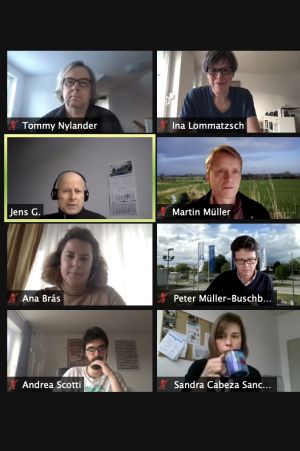
The newly elected II. MLZ User Committee during the first meeting with the MLZ Directorate Peter Müller-Buschbaum and Martin Müller and the MLZ User Office (Ina Lommatzsch): Chair Tommy Nylander, Jens Gibmeier, Ana Bras Würschig, Andrea Scotti, Sandra Cabeza (from top). © MLZ
On the behalf of the newly elected User Committee, I would like to welcome you all to get in touch with us concerning the activities at MLZ. A year into the covid-19 pandemic, I’m sure we all are eager to get started with experimental work. We see some positive signs with the role out of the vaccines, the spring that soon is arriving and the prospect of soon being able to start with experimental work at MLZ. I’m sure you all have had time to reflect on how the world would look like in the post-pandemic era. What we want to do when we are allowed to travel, to meet and catch up with our family, friends and colleagues of which many have become our friends! There are some of us that have lost friends and family in this pandemic and our thoughts goes to all of you who have lost a dear one.
Many of our experiments have been postponed and will be changed. This put a lot of stress in particular on the PhD students and postdocs, who now had their plans drastically changed outside their own control. They have now also not been able to do much work in their own laboratory at their home university. This clearly will put additional challenges on their prospect on their career. I want you to know that the MLZ User Committee is always ready to help and sometimes a few advices regarding alternative experimental routes and possibilities in optimising beam time prospects and experiment, contacts with expertise in the field, and maybe only some lines of friendly encouragement make a lot of difference! Even if our role is to focus on being the link between the user community and the MLZ management and activities, it is not only our duty, but also our pleasure to help the neutron community in a wider perspective.
Now we all have had a chance to think about future challenges in science and we would like to get your thoughts how MLZ can better serve you and how we should approach the possibilities to start up the experimental program at MLZ. So please get in touch with us! We are all eager to help and happy to get out of the Zoom world comfort zone. The spring is evidently on the way even in Wiking land outside my window. Very much looking forward to hearing from you soon and see you all in person in not a too distant future.
Stay safe and take care.
Tommy Nylander (Chair)
Contact
Find all details about the MLZ User Committee on their web page. and contact them either via the personal email addresses or via usercommittee@mlz-garching.de – it is directed to the committee’s chair, Tommy Nylander.
DAPHNE4NFDI received funding
“Hello xy, I am searching for some details of our measurements in March 2019. Upps, no, maybe November 2018 – did you still have them?” How often did you call any instrument scientist for example at the MLZ and ask such a question? Yes, you made a lot of notes, you saved a lot of data – but your laptop crashed in the mean time and during the last move to another job you lost several notebooks.
Dreaming of...
How great would it be to log in via GhOST and get access to all relevant data there: Meta data of the whole configuration, the sample details as well as all measured data of all your experiments here at MLZ? And even better, if you could also directly use a dedicated software for data analysis and then connect all this to your recent publication because the raw data are identified by a DOI?
The idea of NFDI e.V.
Letting this dream come true is one of the big goals of the German National Research Data Infrastructure (NFDI e.V.), a network of independent consortia from different disciplines. At the moment, 19 consortia receive funding – and since July 2nd, DAPHNE4NFDI (DAta from Photon and Neutron Experiments for NFDI), representing more than 5500 German neutron and photon users, is among them. 18 institutes and universities including the MLZ partners collaborate within DAPHNE4NFDI with the aim to enable ‘FAIR’ data – i.e. data that is Findable, Accessible, Interoperable and Reusable, in the area of photon and neutron science. (find more details in this news article on our web page).
How you can contribute
The project will officially start October 1st, 2021 and funding is dedicated to staffing and thus we are soon searching for new colleagues! If you are interested, don’t forget to have a look at our career web page.
And keep always in mind: Each neutron and photon user is invited to contribute to this project in order to establish and promote community standards, e,g, for metadata or best practices for analysis tools. So watch out for upcoming DAPHNE4NFDI events!
Preparing for remote experiments at MLZ
If there is only one lesson learned from the Corona-pandemic: Nearly everything has to be realized also in a virtual way. Preparing access to remote experiments got a real push from that situation and with the funding of DAPHNE4NFDI, we look forward to tackle this problem even in a wider context. Collecting and organizing data according to the FAIR principles will go hand in hand with remote access during the experiment itself.
How will remote access work?
First, it has to be discussed for which experiments remote access can be offered. This means, the instrument scientist and the users will have to have a close look at the experimental plan and check if it is really possible to conduct it here without the user group. If everything looks feasible, the group shall participate via TeamViewer, follow (and control) the conduction of the experiment and receive the live data as they are produced.
Please note: Because we plan to organize the remote access via GhOST, only members of the Experimental Session Team will then be able to get access to the remote sessions – it is the same procedure as for visitors on-site. Thus, all main proposers will always be asked to enter the names and email-addresses of the team members into the proper form in GhOST – as well for experiments on-site as remote.
|
Welcome to the MLZ Newsletter!
The MLZ Newsletter is sent directly to your inbox. All our users are invited to subscribe to it via GhOST!
You aren’t a scientific user but interested? Then just send an email to the MLZ User Office!
MLZ is a cooperation between:
 > Technische Universität München
> Technische Universität München > Helmholtz-Zentrum Hereon
> Helmholtz-Zentrum Hereon
 > Forschungszentrum Jülich
> Forschungszentrum Jülich
MLZ is a member of:
 > LENS
> LENS > ERF-AISBL
> ERF-AISBL
MLZ on social media:



